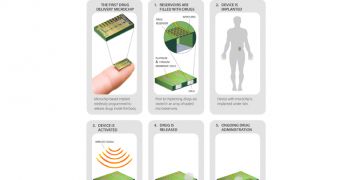A company called Microchips has made headlines these days with a project designed to deliver a birth control drug through a chip implanted under the skin.
This is not the only purpose for the micro device, though, as its potential extends to administrating other drugs, too.
Taking into consideration the inefficient protection portable medical devices have proven to have, concerns about the security risks for the wearer of this type of microchip arise.
The device is conceived with multiple reservoirs protected within the body, each containing the necessary drug dose a patient needs to be delivered. These can be opened on demand or at specific time intervals.
Opening them on demand is the concerning part, because, should someone be able to circumvent the built-in protection, the action poses a significant risk for the wearer of the chip.
According to the company, activating the delivery of the drug is done through electrical signals that melt the membrane of a reservoir, releasing the content into the body of the patient.
The technology has been developed by the scientists at MIT and they licensed it to Microchips, which specializes in medical technology.
The drug release signal is sent wirelessly (radio frequency) from a remote control and, as is the case of many wireless technologies, it presents the risk of being hacked.
However, Microchips President and COO, Robert Farra, told Mashable that the technology would be built to include security measures, such as a very limited range of the wireless signal sent by the remote control.
Farra says that the distance will be of just a few centimeters, which would require a threat actor to get in very close proximity to the victim. The short range does not permit a hacker to intercept the signal, either.
Also, it would be possible to set a password for the remote control, although this would not be very reassuring considering the various ways that can be used to find a countersign.
At this stage of development, it may appear that there are no feasible ways for a hacker to tamper with the device and the way it releases the drugs, but as it was the case with numerous technologies, means to circumvent security are found most of the time and these generally appear after the technology opens up to a wider audience.
The device has already been subject to clinical human trials, on women suffering from osteoporosis, and the results were successful. Both the device and the drug combination were bio-compatible with the patients.

 14 DAY TRIAL //
14 DAY TRIAL //